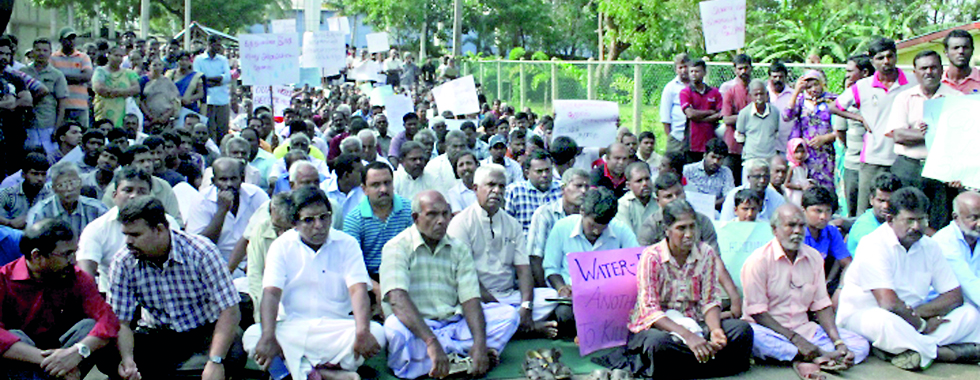News
Northern power plant’s waste oil contaminates region’s water supply
When the Northern Power Plant (NPP) was set up in 2009 in the Valikamam area, nobody would have thought of having to face a serious shortage of drinking water, which made them demand an immediate closure of the station after five years.
Residents of surrounding areas took to the streets yesterday to protest opposite the plant, demanding an immediate solution, after their complaints to provincial and central government authorities went unheeded.

A protest in the area
The Northern Power Plant operating inside the Ceylon Electricity Board (CEB) premises in Chunnakam, releases waste oil which seeps into the underground water springs in the region and contaminates the wells.
Nearly 10,000 families from two Divisional Secretariats have been severely affected. Valikamam South and North with around 20,000 people facing an imminent threat which continues to spread eastwards too.
Chunnakam Pradeshiya Sabha Development Officer, R. RameshKumar said it has affected surrounding areas to a radius of about 6 km and continues to spread.
“Earlier, I visited the power plant station and saw three wells, each of 60-feet depth, for underground storage of the waste oil. On inquiry, I was told they have been closed a long time ago,” he said.
“This issue came to light in 2012 and we have complained to many authorities to no avail. That’s why we finally decided to invade the plant,” said Chunnakam Community Centre President K. Kajendran.
Residents in the area argued that, since a new power plant called ‘Uthuru Janani’ was set up in 2013, the NPP is used only to meet peak hour demand, and hence can be stopped.
They also alleged there was no proper Environmental Impact Assessment (EIA) tests carried out before setting up the plant.
“Now the contamination of the water has worsened. We can’t even use this water for washing, bathing, farming or cooking. Most of the families are engaged in farming. The crops and plants are also affected,” he said.
Mr. Kajendran said that, in recent times, residents in the area have developed skin eruptions.
“The Provincial Ministry is helping us by providing water in bowsers every day. We need a permanent solution to this,” he said.
A senior doctor attached to the Regional Director of Health Services (RDHS), Jaffna, said people living in these areas have been instructed through Public Health Inspectors (PHIs), not to use the contaminated water for drinking or cooking purposes.
“We have identified this as a serious issue with long term side effects, if they continue using the water. It may take 5 to 10 years to identify the affected people,” he said.
Northern Provincial Council (NPC) Agriculture Minister P. Ayngaranesan said the NPC has appointed a committee comprising university academics from the North and the South to study the problem.
“The committee will commence its investigations on January 27. This is a longstanding issue which cannot be resolved in a short time. We will work with the Government to solve this. There is also a project in Marudankeni to convert sea water into drinking water. The affected area will be included into this water supply unit once the project is completed,” he said.
Meanwhile, Tamil National Alliance (TNA) Parliamentarian Dharmalingam Siddharthan told the Sunday Times that, when they met President Maithrpala Sirisena on Monday, they raised this issue as the main concern of the Northern people.
“President Sirisena noted the issue but gave no assurance. We will take up this matter even further in future for a permanent solution,” he said.

